Table of contents
- Comparison test: KTM 990 Super Duke, Moto Morini Corsaro 1200 Veloce, Triumph Speed Triple, Yamaha FZ1 Bang gang
- KTM 990 Super Duke
- Moto Morini Corsaro 1200 Veloce
- Triumph Speed Triple
- Yamaha FZ1
- Funbike comparison test – PS 6/2008
- Funbike comparison test – PS 6/2008
- PS rating
- PS data
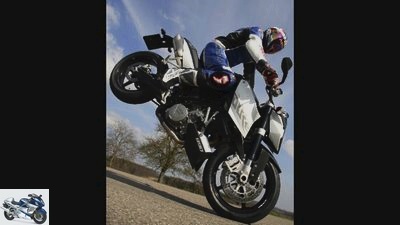
Bilski
motorcycles
Comparison test: KTM 990 Super Duke, Moto Morini Corsaro 1200 Veloce, Triumph Speed Triple, Yamaha FZ1
Comparison test: KTM 990 Super Duke, Moto Morini Corsaro 1200 Veloce, Triumph Speed Triple, Yamaha FZ1
Bang gang
Content of
When the best fun bikes from four countries come together for a comparison test at PS, a powerful team emerges. But which concept is the most fun on the country road?
Sebastian Lang
06/11/2008
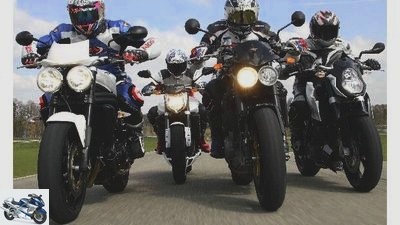
Bilski
The eye goes with you – the four sharp nakeds not only go very different in terms of design.
Cornfield instead of gravel, Sunday drivers instead of marshals. When the house track calls at the weekend and super athletes with slick tires doze comfortably in the corner of the garage, it’s time for fun bikes. Every manufacturer interprets what exactly is meant by this type of motorcycle. Basic rules: little disguise, a lot of boom and a lot of charm. PS grabbed the Austrian alpine racer KTM 990 Super Duke, the radically styled Yamaha FZ1, the facelifted Triumph Speed triple and Moto Morinis 1200 Corsaro in the noble version Veloce, to find out which fun motorcycle conjures up the biggest grin under the helmet.
First clue: the optics. Parade discipline of Italian emotions and thus home game for the Corsaro Veloce. With its curved line, the crisp one
Butt and beautiful details such as the triple clamped fork bridge, the lovingly designed display, the noble Termignoni exhaust system and the chic accessory footrest system electrify you even before you press the start button. Even Triumph’s flagship Streetfighter Speed Triple has to take a back seat. In 2008 the Speedy remained true to its character traits of double headlights, mini mask and chubby butt, but wore its 180 cm Dunlop rear tire on a new, beautifully curved rim.
KTM 990 Super Duke
KTM looked at his 990 Super Duke on the other hand no need for change. She was, is and will remain the extreme? even when stationary. Edges, corners, plastic parts, wherever you look. The KTM has everything you need to ride? but nothing more. No comparison to the lavishly furnished Morini.
Even Yamaha spices up its fun bike with delicious extras such as the striking accessory keel and thus divides the camps. While some speak enthusiastically of the most Italian naked Japanese woman and praise the interplay of the aggressive front mask, sleek tank and fat engine, the other half averts their eyes in horror and puzzles how much sake the Japanese designer probably used when drawing the FZ.
Moto Morini Corsaro 1200 Veloce
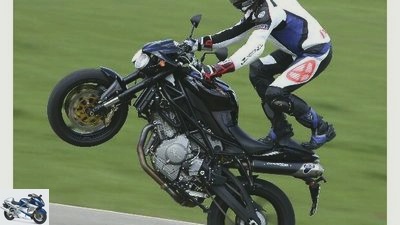
Bilski
The Corsaro Veloce impresses with its external values and delights Italian aesthetes. The Kat disturbs something and likes to hit the corner.
But before the blood alcohol level can be fully discussed, a bloodcurdling thump destroys further arguments. Origin of the bass aria: the exhaust system of the Moto Morini. The volume of the Termignonis borders on the outrageous even when idling, but it makes the stomach of two-cylinder fetishists tingle. That goes away with the first attempt at start-up. The torque drop at 2500 rpm and the cold running behavior, which is in need of improvement, put an abrupt end to the sonorous engine hum when the clutch is carelessly disengaged. In times of programmable injection maps, that would be better.
Once in motion, the engine shows its very strong side and thunders forward from 3000 rpm like no other motorcycle in the test field. Gigantic. The front wheel cannot withstand the torque waves from 1200 cm³ in the first two gears and flees towards the sky. From 7000 rpm, however, the Italian noticeably loses pleasure and asks for the next higher gear. So hand on the clutch, use the short gear lever to slide the next gear into the somewhat creaky gearbox and engage. The presence of the anti-hopping clutch is noticeable through a noticeable pulsation of the clutch lever. Those who like to move with two fingers on the lever have to get used to this momentum.
The Corsaro Veloce’s throttle response is beyond any doubt. The forward thrust can be dosed wonderfully smoothly, the load changes are low despite the strong engine braking torque. This is how the driver really enjoys it, especially on winding country lanes. Unfortunately at the expense of those driving behind, because the Morini not only offers a sound, but also a smell experience: incomprehensible how a motorcycle with fuel injection, Kat and Euro3 can stink so badly. The high consumption, the smell and the black muffler inner pipes suggest a very rich engine set-up.
Triumph Speed Triple
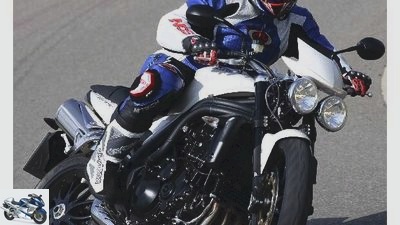
Bilski
The chrome-plated double headlights, the mask and the triple clamped fork bridge are typical of the Speedy.
The Speed Triple can only smile wearily at such problems. In British understatement, she holds back elegantly at the gas station and is content with 6.4 liters of fuel per 100 kilometers. It is all the more gratifying that the engine characteristics do not have to suffer as a result. The naked British woman sprints through the rev range with vigor and does not let up until the limiter. The silky engine run and the three-cylinder symphony from the mufflers crown the show. Only the rustic gearbox and the somewhat hard throttle response cloud the performance minimally.
The Duke is still struggling with this problem. Your engine is a real choleric; gentle bobbing is not possible with him. Once irritated, angry
he goes like there’s no tomorrow. Despite the nominally lowest peak power, the engine reacts so greedily to every millimeter of throttle pull that the pilot’s grin threatens to blow his helmet. In contrast to Moto Morini puts the KTM at high speeds even a few more coals and shoots away with the front wheel raised. But be careful: If you succumb to the extreme character of the Duke, you will no longer have any breaks when riding your motorcycle. She constantly screams for more and sneakily lures the pilot into illegal speed ranges.
Yamaha FZ1

Bilski
Japanese in street fighter look: The FZ1 is a topic for discussion.
The Yamaha rider knows that too, but the reason for the high speed is the FZ1 not a gluttonous two-cylinder, but a revving four-cylinder. The slightly modified Thousand, taken from the super sports sister R1, accelerates wonderfully smoothly, but looks listless at low speeds and only really starts at 7000 rpm. Then he really mixes up the horsepower in the combustion chambers and chases towards the horizon at 11,500 rpm with almost 150 hp. Unfortunately, this speed is only at over 100 km / h.
In addition to the engine characteristics, the gear ratio is also responsible for the illegal driving pleasure. The ratio of the FZ1 is far too long for a naked bike and only turns into the limiter in sixth gear at over 260 km / h. A smaller sprocket makes the Yamaha noticeably livelier and significantly increases the fun on tight bends.
There, however, it has to struggle with its sluggish handling. The 190 rear tire stubbornly defends itself against rapid changes of direction and requires a lot of physical effort from the pilot. Especially on the brakes, the FZ1 drives stubbornly straight ahead, while the pilot desperately tugs at the handlebars. Yamaha seems to be looking for driving pleasure in wide arcs rather than narrow angles.
The well-balanced chassis, on the other hand, also cuts a fine figure on second-class hopping slopes. The fork and shock absorber of the FZ1 are relatively soft, but respond cleanly and keep the fat Yamaha safely on course. Only with very nasty bumps does the wide, straight handlebar twitch from time to time. Overall, the seating position takes a bit of getting used to. The rider sits more in than on the motorcycle, the pegs are mounted far in front and subjectively high up. Nevertheless, the notch nipples drag over the asphalt very early and put an end to the fun on the bends. Perhaps both the driver’s seat and footrests would be better off in a higher position.
Funbike comparison test – PS 6/2008
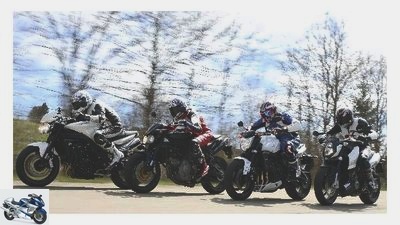
Bilski
The sporty seating position and the great engine are the big pluses of the Speed Triple.
For example with the Speed Triple. The high seating position and the deep stumps maneuver the pilot into a sporty, but long-distance-suitable position. The feet find their way to the high footpegs, which are positioned much further back compared to the Yamaha. The chassis underscores the sporty character: the fork works sensitively and keeps the front wheel on the ground even in the event of bad hits. The stiff shock absorber still works a bit insensitively and passes short, hard blows on to the pilot’s rear almost unfiltered.
In the curve, the English woman shows her sunny side, falls light-footed in an inclined position, obediently follows the wishes of the pilot and only requires minimal course corrections in order to find the optimal way to exit the curve. The new Brembo front brake with single pads also does a good job. Not overbite, but very easy to control, it safely brakes the driver and driver after wild acceleration orgies. A factual improvement over the old stoppers could not be seen in the test, but the rather large free travel of the brake lever was noticeable.
The brakes of the KTM also work perfectly? and is just as extreme as the engine: two fingers are enough to make the rear of the angular Austrian soar with minimal effort. A dream in the dry, not entirely harmless in the wet. The stiff chassis of the Duke can hardly be impressed by the powerful engine and the poisonous brake on the country road. With sufficient reserves, it cushions all bumps that get in its way. Only the rebound of the shock absorber turned out to be a bit soft and couldn’t be significantly improved even with setup changes.
The seating position, on the other hand, fits perfectly. The Austrian fun bike places its pilot high up and in front and gives him the feeling of sitting directly over the front wheel. The relaxed knee angle and the wide handlebars literally invite you to burn in serpentines for hours. This is where the KTM feels particularly at home. No other in the test field can be folded down so playfully and driven through the curve on a razor-sharp line; more fun is not possible. The Dunlops harmonize very well with the Duke and always give the pilot a feeling of security.
Funbike comparison test – PS 6/2008
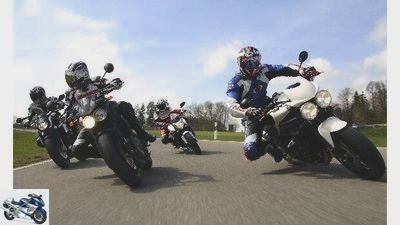
Bilski
Compared to the KTM and Triumph, the Yamaha looks very clumsy on narrow streets. She prefers wide arches.
You miss this feeling a little on the Morini. The taut fork makes the Italian very restless on bumpy ground and makes her wriggle angrily with the handlebars when it hits harder. Even with the compression stage completely open, the full feel for the front wheel that you have with the Duke and the Yamaha is missing. The stylish Ohlins shock does its job a bit, but not significantly better. Here, too, the setup got a little too tight, which affects the responsiveness. The brakes do their job better: the Brembo stoppers bite into the 320 discs without an overly sporty bite, but easily controlled. However, the Corsaro Veloce tends to pitch up when braking in an inclined position and forces the pilot to correct course.
The beefy engine doesn’t make it any easier. With its strong braking torque and rustic use of power, it makes it difficult to achieve a clean line despite the low load change reactions. Once the pilot has found this, he has to be prepared for a cat touching down on undulating right turns. Otherwise, the lean angle is okay.
The pegs are placed quite high without imposing an overly sporty posture on the pilot. Overall, the seating position of the Morini is more touristy. Similar to the Yamaha, the rider sits more in the motorcycle than on the motorcycle and, because of the high handlebars, has a less direct feel for the front wheel than with the KTM or Triumph. Not necessarily worse, but different. Every manufacturer has their own idea of what the perfect fun bike should look like.
Conclusion: It doesn’t always have to be a super athlete. As the extremum of the quartet, the Super Duke particularly impresses with its great engine and playful handling. As an all-rounder, the Speed Triple is up to both sporting and tourist demands. Moto Morini’s Corsaro Veloce relies on classic Italian values. With a lot of visual and acoustic emotion, she conquered the hearts of the fans. The FZ1 shows that the Japanese can also build exciting fun bikes.
PS rating
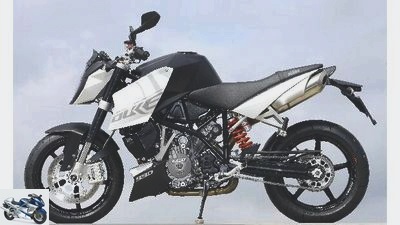
Bilski
KTM 990 Super Duke
Drive: ****
The Duke’s engine is a real lethal injection. It hangs on the gas very aggressively at every speed, but annoys with hard load changes.
Landing gear: ****
The spring elements of the KTM work at a high level. Only the shock absorber needs more rebound. The brakes are a dream.
Ergonomics: *****
Relaxed knee angle, very front-wheel-oriented seating position, the driver is not more active on any other motorcycle in the test field.
Driving pleasure: *****
The great Duke is pure fun. The greedy engine, the great brakes, plus the feather-light handling and the active seating position. It couldn’t be better.
PS judgment: Caution: risk of permanent grinning. The Super Duke is the epitome of a fun bike and deserves the win. The high fun potential is addicting.
18 points, 1st place

Bilski
Moto Morini Corsaro 1200 Veloce
Drive: ****
The Morini’s 1200 twin is particularly impressive below 7000 rpm. The low load changes and the great sound are inspiring, the exhaust gases are not.
Landing gear: ***
The chassis of the Corsaro Veloce is too tight and insensitive for the country road. The Italian tends to hit the handlebars on mogul slopes.
Ergonomics: ****
In a relaxed upright position, the pilot sits comfortably on the Morini. The pegs are placed quite high, the driving experience is more indirect than with KTM.
Driving pleasure: ****
The Morini is the only one in the test field to have an anti-hopping clutch. The engine is a force, the sonorous exhaust sound arouses emotions.
PS judgment:
The Corsaro Veloce can’t quite keep up with Speed Triple and Super Duke. Still, it is an interesting motorcycle with a lot of fun potential.
15 points, 3rd place
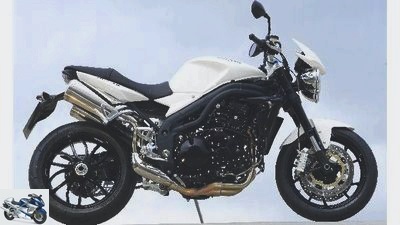
Bilski
Triumph Speed Triple
Drive: *****
The Speed Triple’s engine is a delight. Silky smooth running, pressure over the entire speed range. 5 points despite the creaky gearbox.
Landing gear: ****
The tight chassis of the Speedy cannot be broken down on the country road. the fork works sensitively, the shock absorber looks a bit bumpy.
Ergonomics: ****
The seating position on the Speed Triple is quite sporty. High pegs placed far back, low handlebars. The tank is relatively wide.
Driving pleasure: ****
The Triumph is an all-rounder with fun potential. With pure serpentine burning, however, she has to give way to the extreme duke.
PS judgment:
One point behind the KTM, the Speedy landed in second place. It makes both piste burners and touring enthusiasts happy.
17 points, 2nd place

Bilski
Yamaha FZ1
Drive: ***
You can clearly see the R1 genes of the FZ1. Below 7000 rpm it seems listless. It is only really fun from 10,000 rpm. The throttle response is very good.
Landing gear: ****
The Yamaha doesn’t want to go around the corner on the brakes. The footpegs touch down very early. The brakes are great, the ABS also works well.
Ergonomics: ***
In terms of seating position, the FZ1 goes very unconventional ways. The wide, straight handlebars and the high, front-mounted pegs take getting used to.
Driving pleasure: ***
The Japanese woman doesn’t really feel at home on narrow country lanes; their profession are long, fast corners. It’s really fun there.
PS judgment:
The Japanese fun bike concept lags a bit behind the competition from Europe. With a shorter translation, more might be possible.
13 points, 4th place
PS data
KTM 990 Super Duke
Drive: Two-cylinder 75-degree V-engine, four valves / cylinder, 88 kW (120 PS) at 9000 / min *, 100 Nm at 7000 / min *, 1000 cm³, bore / stroke 101.0 / 62.4 mm,
Compression ratio: 11.5: 1, ignition / injection system, 48 mm throttle valves, hydraulically operated multi-disc oil bath clutch, six-speed gearbox, G-Kat
Landing gear: Steel tubular space frame, steering head angle: 66.1 degrees, caster: 100.7 mm, wheelbase: 1450 mm. Upside-down fork, Ø fork inner tube: 48 mm, adjustable in spring base, rebound and compression. Central spring strut, adjustable in spring base, rebound and compression stage. Suspension travel front / rear: 135/160 mm
Wheels and brakes: Light alloy cast wheels, 3.50 x 17″/5.50 x 17″ , Front tires: 120/70 ZR 17, rear: 180/55 ZR 17. First tires: Dunlop Sportmax D 208 RR, 320 mm double disc brake with four-piston fixed calipers at the front, 240 mm single disc brake with single-piston floating caliper at the rear
Measurements and weight: Length / width / height: 2080/910/1235 mm, seat / handlebar height: 845/1030 mm, handlebar width: 750 mm, 203 kg fully fueled, v./h .: 51.2 / 48.8%
Rear wheel power in last gear: 82.3 kW (112 PS) at 229 km / h
Driving performance: Acceleration 0 100/150/200 km / h: 3.4 / 6.0 / 11.0 s, pulling speed 50 100/100 150 km / h: 4.9 / 4.6 s
Top speed: 220 km / h *
Consumption: Fuel type: Super unleaded. Average test consumption: 6.7 liters / 100 km, tank capacity 18.5 liters, range: 276 km
Base price: 12 495 euros (plus ancillary costs)
Moto Morini Corsaro 1200 Veloce
Drive: Two-cylinder 87-degree V-engine, four valves / cylinder, 103 kW (140 PS) at 8500 / min *, 123 Nm at 6500 / min *, 1187 cm³, bore / stroke 107.0 / 66.0 mm, Compression ratio 11.8: 1, ignition / injection system, 54 mm throttle valves, hydraulically operated multi-plate oil bath clutch, six-speed gearbox, G-Kat
Landing gear: Steel tubular space frame, steering head angle: 65.5 degrees, caster: 103 mm, wheelbase: 1440 mm. Upside-down fork, Ø fork inner tube: 50 mm, adjustable in spring base, rebound and compression. Central spring strut with deflection, adjustable in spring base, rebound and compression stage. Suspension travel front / rear: 120/130 mm
Wheels and brakes: Light alloy cast wheels, 3.50 x 17″/5.50 x 17″, Front tires: 120/70 ZR 17, rear: 180/55 ZR 17. First tires: Pirelli Diablo Corsa III,
320 mm double disc brake with four-piston fixed calipers at the front, 220 mm single disc brake with two-piston floating caliper at the rear
Measurements and weight: Length / width / height: 207/905/1255 mm, seat / handlebar height: 820/1030 mm, handlebar width: 725 mm, 218 kg fully fueled, v./h .: 46.8 / 53.2%
Rear wheel power in last gear: 94 kW (128 PS) at 218 km / h
Driving performance: Acceleration 0 100/150/200 km / h: 3.4 / 6.0 / 10.3 s, pulling 50 100/100 150 km / h: 6.2 / 4.6 s
Top speed: 250 km / h *
Consumption: Fuel type: Super unleaded. Average test consumption: 8.3 liters / 100 km, tank capacity 17 liters, range: 205 km
Base price: 13895 Euro (plus additional costs)
Triumph Speed Triple
Drive: Three-cylinder in-line engine, four valves / cylinder, 97 kW (132 PS) at 9250 / min *, 105 Nm at 7500 / min *, 1050 cm³, bore / stroke 79.0 / 71.4 mm, compression ratio 12.0: 1 , Ignition / injection system, 46 mm throttle valves, mechanically operated multi-disc oil bath clutch, six-speed gearbox, G-Kat
Landing gear: Light metal bridge frame, steering head angle: 66.5 degrees, caster:
84 mm, wheelbase: 1429 mm. Upside-down fork, Ø fork inner tube: 45 mm, adjustable in spring base, rebound and compression. Central spring strut with deflection, adjustable in spring base, rebound and compression stage. Suspension travel front / rear: 120/140 mm
Wheels and brakes: Light alloy cast wheels, 3.50 x 17″/5.50 x 17″, Front tires: 120/70 ZR 17, rear: 180/55 ZR 17. First tires: Dunlop Qualifier, 320-
mm double disc brake with four-piston fixed calipers at the front, 220 mm single disc brake with two-piston floating caliper at the rear
Measurements and weight: Length / width / height: 2130/780/1260 mm, seat / handlebar height: 840/1000 mm, handlebar width: 740 mm, 221 kg fully fueled, v./h .: 48.3 / 51.7%
Rear wheel power in last gear: 92 kW (125 PS) at 236 km / h
Driving performance: Acceleration 0 100/150/200 km / h: 3.5 / 5.8 / 10.2 s, pulling 50 100/100 150 km / h: 4.1 / 5.7 s
Top speed: 240 km / h *
Consumption: Fuel type: Super unleaded. Average test consumption: 6.4 liters / 100 km, tank capacity 18 liters, range: 281 km
Base price: 11440 Euro (plus ancillary costs)
Yamaha FZ1
Drive: Four-cylinder in-line engine, four valves / cylinder, 110 kW (150 PS) at 11000 / min *, 106 Nm at 8000 / min *, 998 cm3, bore / stroke 77.0 / 53.6 mm, compression ratio 11.5: 1 , Ignition / injection system, 42 mm throttle valves, mechanically operated multi-disc oil bath clutch, six-speed gearbox, G-Kat
Landing gear: Light alloy bridge frame, steering head angle: 65.0 degrees, caster: 109 mm, wheelbase: 1460 mm. Upside-down fork, Ø fork inner tube: 43 mm, adjustable in spring base, rebound and compression. Central spring strut with deflection, adjustable in spring base, rebound and compression stage. Suspension travel front / rear: 130/130 mm
Wheels and brakes: Light alloy cast wheels, 3.50 x 17″/6.00 x 17″, Front tires: 120/70 ZR 17, rear: 190/50 ZR 17. First tires: Dunlop D 221 “A.”, 320 mm double disc brake with four-piston fixed calipers at the front, 255 mm single disc brake with single-piston floating caliper at the rear
Measurements and weight: Length / width / height: 2140/790/1240 mm, seat / handlebar height: 800/1010 mm, handlebar width: 685 mm, 217 kg fully fueled, v./h .: 50.2 / 49.8%
Rear wheel power in last gear: 97 kW (132 PS) at 267 km / h
Driving performance: Acceleration 0 100/150/200 km / h: 3.6 / 5.9 / 10.3 s, pulling speed 50 100/100 150 km / h: 5.2 / 5.3 s
Top speed: 252 km / h *
Consumption: Fuel type: Super unleaded. Average test consumption: 6.8 liters / 100 km, tank capacity 18 liters, range: 265 km
Base price: 10195 Euro (plus ancillary costs)
* Factory specification
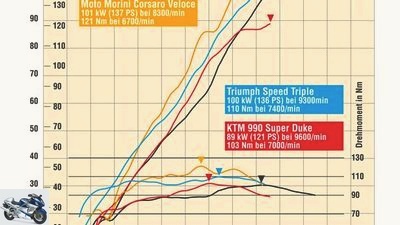
Power on the crankshaft; Measurements on Dynojet chassis dynamometer 150
The diagram underlines the driving impressions. The Yamaha needs speed to really get going. Only at 7000 rpm does it really move forward. In terms of torque, too, she can’t quite keep up with her three competitors? annoying on the country road. The morini is the exact opposite. From almost 4000 rpm, it continuously sends over 100 Nm to the crankshaft, especially the mountain up to 7000 rpm is really fun. In the upper speed range, however, it loses the desire, which is reflected in the performance curve
clearly reflects. The KTM engine is the most fun despite the lowest peak power: The torque curve, which rises to 7000 rpm, brings a lot of fire to the rear wheel. The Triumph shows the most homogeneous performance: linearly increasing performance, plus a fat mountain of torque. The diagram does not show that it also runs as smooth as silk.
Related articles
-
Comparison test Kawasaki Ninja ZX-6R, Triumph Daytona 675, Yamaha YZF-R6
Fact 9 pictures triumph 1/9 Triumph Daytona 675 triumph 2/9 Triumph Daytona 675 triumph 3/9 Triumph Daytona 675 triumph 4/9 Triumph Daytona 675 triumph…
-
Concept comparison: Honda Fireblade, KTM 990 Super Duke R, Suzuki GSX-R 600, Yamaha FZ6
Gargolov motorcycles Concept comparison: Honda Fireblade, KTM 990 Super Duke R, Suzuki GSX-R 600, Yamaha FZ6 Concept comparison: Honda Fireblade, KTM 990…
-
Concept comparison: Kawasaki, Triumph, Yamaha
K motorcycles Concept comparison: Kawasaki, Triumph, Yamaha Concept comparison: Kawasaki, Triumph, Yamaha Fabric for Zoff Content of The liter is a handy…
-
Comparison test Ducati 1098S, Honda Fireblade, KTM 1190 RC8, Triumph Daytona 675, Yamaha YZF-R6
Jahn motorcycles Comparison test Ducati 1098S, Honda Fireblade, KTM 1190 RC8, Triumph Daytona 675, Yamaha YZF-R6 Comparison test Ducati 1098S, Honda…
-
fact motorcycles Comparison test: Honda CBR 600 RR, Kawasaki ZX-6R, Suzuki GSX-R 600, Triumph Daytona 675, Yamaha YZF-R6 Comparison test: Honda CBR 600…
-
Comparison test: large naked bikes
K motorcycles Comparison test: large naked bikes Comparison test: Large naked bikes, Ducati Monster S4, Kawasaki Z 1000, KTM 990 Super Duke R, Triumph…
-
Comparison test: 600cc extreme athlete
K motorcycles Comparison test: 600cc extreme athlete Comparison test: 600cc extreme athlete Spear tips Content of They flaunt long lances at the end, are…
-
Comparison test: BMW R 1200 GS, Ducati Hypermotard 1100 S, KTM 990 Supermoto
Jahn motorcycles Comparison test: BMW R 1200 GS, Ducati Hypermotard 1100 S, KTM 990 Supermoto Comparison test: BMW R 1200 GS, Ducati Hypermotard 1100 S,…
-
fact motorcycles Test: Triumph Street Triple R Test: Triumph Street Triple R Mr. R Content of Mr. R is a respectable person. Not because he wears a…
-
Comparison test MV Agusta Turismo Veloce 800 and Yamaha MT-09 Tracer
Bilski 19th pictures MOTORCYCLE 1/19 Power on the crankshaft. Measurements on the Dynojet roller test stand 250, corrected according to 95/1 / EG,…